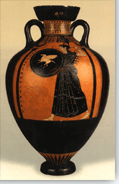









         | |
|
One of the last important painters of vases of the black-figure style was the Antimenes Painter. Most of his works are dated between |
Many kylix painters repeat trivial motifs, such as the gorgoneia and composite animals. The eye kylikes are widely spread and sometimes are influenced by the "Chalcidian" standards of the west. Im the final black-figure vases is included the multitudinous series of the vases known as the lekythoi. Although these forms become less and less attentive, their motifs are schematically formed and their production is almost massive, the black-figure lekythoi continuing to be produced until the second quarter of the |
 |
A special category of vases are the Panathenian amphoras. Their shape and decoration were formulated around |
|
| |
|
Note: Click on picture for short description. | |